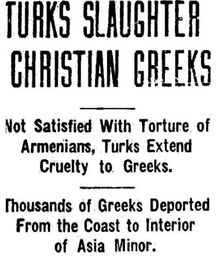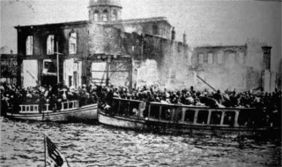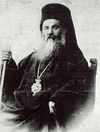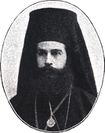إبادة اليونانيين البنط
| إبادة اليونانيين Greek genocide | |
|---|---|
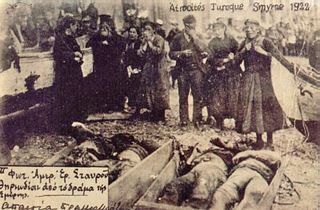 مدنيون يونانييون ينتحبون على أقاربهم المتوفين، حريق سميرنا الكبير، 1922. | |
| المكان | الدولة العثمانية |
| التاريخ | 1913–1923 |
| الهدف | السكان اليونانيون، البنط، الكاپادوكيون، واليونيون. |
نوع الهجوم | تهجير، قتل جماعي، مسير موت، وأخرى. |
| الوفيات | 450,000-900,000 (انظر قسم الضحايا أسفل المقال) |
| المنفذون | الدولة العثمانية، الحركة الوطنية التركية |
إبادة اليونانيين، وتعرف أيضاً بإبادة البنط، هي عملية تطهير عرقي ممنهج للسكان المسيحيين اليونانيين العثمانيين من وطنهم التاريخي الأناضول أثناء الحرب العالمية الأولى وما بعدها (1914-23). قامت بها حكومة الدولة العثمانية ضد السكان اليونانيين بالامبراطورية وشملت مذابح، تهجير قسري تضمن مسيرات موت، الطرد العاجل، الإعدام التعسفي، وتدمير الآثار الثقافية، التاريخية والدينية المسيحية الأرثوذكسية. حسب مصادر مختلفة، توفى في تلك الفترة مئات الآلاف من اليونانيين العثمانيين.[1] معظم اللاجئين والناجين فروا إلى اليونان (مشكلين ما يقارب ربع سكان اليونان).[2] بعضهم، خاصة المقيمين في المحافظات الشرقية، لجئوا إلى الامبراطورية الروسية المجاورة. مع نهاية الحرب اليونانية التركية 1919-1922، معظم يونانيو آسيا الصغرى إما فروا أو قُتلوا.[3] من تبقى منهم رُحلوا إلى اليونان بشروط تبادل السكان بين اليونان وتركيا اللاحق عام 1923، والتي قضت بمنع عودة اللاجئين. جماعات عرقية أخرى تم مهاجمتها بطريقة مشابهة من قبل الدولة العثمانية، منهم الآشوريين والأرمن، وقد اعترف الباحثين والمنظمات بهذه الأحداث كجزء من سياسة الإبادة المماثلة.[4][5][6][7][8][9][10][11]
أدان حلفاء الحرب العالمية الأولى المذابح التي أرتكبت برعاية الحكومة العثمانية بوصفها جرائم ضد الإنسانية. في الآونة الأخيرة، أصدرت الرابطة الدولية لباحثي الإبادة قرار في 2007 يعترف بالحملة العثمانية ضد الأقليات المسيحية في الامبراطورية، ومنهم اليونانيين، بوصفها إبادة جماعية.[12] أصدرت بعض منظمات الأخرى أيضاً قرارات تعترف بالحملة على أنها إبادة، وكذلك فعلت برلمانات اليونان، قبرص، السويد، أرمنيا، هولندا، والنمسا.
خلفية
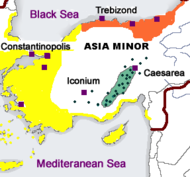
الأحداث
ما بعد حروب البلقان
| إجمالي أعداد السكان اليونانيين العثمانيين في الأناضول [14] | |||
| تعداد اليونانيين (1910–12) | تعداد العثمانيين (1914) | Soteriades (1918)[15] | |
|---|---|---|---|
| Hudavendigar (Prousa) | 262,319 | 184,424 | 278,421 |
| Konya (Ikonio) | 74,539 | 65,054 | 66,895 |
| Trabzon (Trebizond) | 298,183 | 260,313 | 353,533 |
| Ankara (Angora) | 85,242 | 77,530 | 66,194 |
| Aydin | 495,936 | 319,079 | 622,810 |
| Kastamonu | 24,349 | 26,104 | 24,937 |
| Sivas | 74,632 | 75,324 | 99,376 |
| Izmit (Nicomedia) | 52,742 | 40,048 | 73,134 |
| Biga (Dardanelles) | 31,165 | 8,541 | 32,830 |
| الإجمالي | 1,399,107 | 1,056,357 | 1,618,130 |

الحرب العالمية الأولى
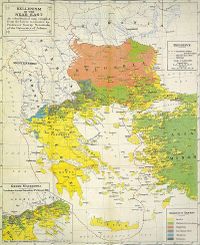
الحرب اليونانية التركية
تبعا للوثائق الرسمية العثمانية، في يناير 1919، سمحت الحكومة العثمانية بعودة بعض اليونايين الذين تم ترحيلهم ومنحهم مساعدة مالية وردت لهم ممتلكاتهم.[16]
جهود الإغاثة
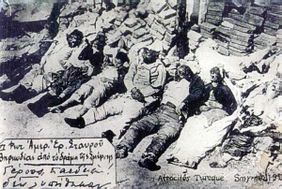
الخسائر

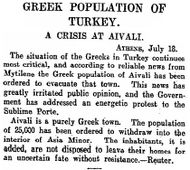
الاعتراف بالإبادة
المصطلح
صيغت كلمة إبادة في أوائل الأربعينيات، في فترة الهولوكوست، من قبل رفائيل لمكين، محامي پولندي من أصل يهودي. في كتاباته عن الإبادة، اشتهر لمكين باستفاضته في الحديث عن مصير اليونانيين في تركيا.[20] في أغسطس 1946 أفادت نيويورك تايمز:
الإبادة ليست ظاهرة جديدة، كما لم يتم تجاهلها في الماضي تماماً... مذابح اليونانيين والأرمن على يد الأتراك دفعت إلى الحراك الدبلوماسي بدون عقاب. إذا كان للبروفيسور لمكين وسيلته لأصبحت الإبادة جريمة دولية...[21]
النقاش الأكاديمي
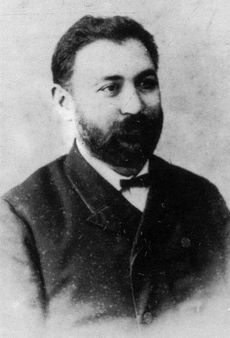
إحياء الذكرى
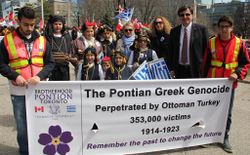
انظر أيضاً
- اقتباسات أكاديمية عن الإبادة
- إبادة الأرمن
- إبادة الآشوريين
- إنكار الإبادة
- پوگروم إسطنبول
- حقوق الإنسان في تركيا
- الرتب العشرين
- فكرة مگالي
- جمهورية البنط
- يونانيون كاپادوكيون
الهامش
- ^ Jones 2006, pp. 154–55.
- ^ Howland, Charles P. "Greece and Her Refugees", Foreign Affairs, The Council on Foreign Relations. July, 1926.
- ^ Matthew J. Gibney, Randall Hansen. (2005). Immigration and Asylum: from 1900 to the Present, Volume 3. ABC-CLIO. p. 377. ISBN 1-57607-796-9.
The total number of Christians who fled to Greece was probably in the region of I.2 million with the main wave occurring in 1922 before the signing of the convention. According to the official records of the Mixed Commission set up to monitor the movements, the "Greeks' who were transferred after 1923 numbered 189,916 and the number of Muslims expelled to Turkey was 355,635 [Ladas I932, 438-439; but using the same source Eddy 1931, 201 states that the post-1923 exchange involved 192,356 Greeks from Turkey and 354,647 Muslims from Greece].
- ^ Jones 2010, pp. 171–2.
- ^ (PDF)IAGS Resolution on Genocides committed by the Ottoman Empire retrieved via the Internet Archive, International Association of Genocide Scholars, http://web.archive.org/web/20080428051032/http://genocidescholars.org/images/Resolution_on_genocides_committed_by_the_Ottoman_Empire.pdf
- ^ "Genocide Resolution approved by Swedish Parliament", News (AM), http://news.am/eng/news/16644.html, containing both the IAGS and the Swedish resolutions.
- ^ Gaunt, David. Massacres, Resistance, Protectors: Muslim-Christian Relations in Eastern Anatolia during World War I. Piscataway, NJ: Gorgias Press, 2006.
- ^ Schaller, Dominik J; Zimmerer, Jürgen (2008). "Late Ottoman genocides: the dissolution of the Ottoman Empire and Young Turkish population and extermination policies – introduction". Journal of Genocide Research. 10 (1): 7–14. doi:10.1080/14623520801950820.
- ^ "Resolution on genocides committed by the Ottoman empire" (PDF). International Association of Genocide Scholars.
{{cite journal}}: Cite journal requires|journal=(help) - ^ Gaunt, David (2006), Massacres, Resistance, Protectors: Muslim-Christian Relations in Eastern Anatolia during World War I, Piscataway, NJ: Gorgias, http://books.google.se/books?id=4mug9LrpLKcC&printsec=frontcover&dq=Massacres,+Resistance,+Protectors&cd=1#v=onepage&q=&f=false
- ^ Schaller, Dominik J; Zimmerer, Jürgen (2008). "Late Ottoman genocides: the dissolution of the Ottoman Empire and Young Turkish population and extermination policies – introduction". Journal of Genocide Research. 10 (1): 7–14. doi:10.1080/14623520801950820.
- ^ (PDF)IAGS officially recognizes Assyrian, Greek genocides, International Association of Genocide Scholars, http://www.genocidescholars.org/sites/default/files/document%09%5Bcurrent-page%3A1%5D/documents/IAGS-Resolution-Assyrian%20and%20Greek%20Genocide.pdf.
- ^ Dawkins, R.M. 1916. Modern Greek in Asia Minor. A study of dialect of Silly, Cappadocia and Pharasa. Cambridge: Cambridge University Press. http://archive.org/details/moderngreekinas00hallgoog
- ^
- Alexandris 1999, p. 54
- Κωστόπουλος 2007, pp. 170–1
- Karpat, Kemal (1985). Ottoman Population, 1830-1914: Demographic and Social Characteristics. Madison: Madison University Press.
- ^ Alexandris 1999, pp. 71–2 states that the 1918 Ethnological Map Illustrating Hellenism in the Balkan Peninsula and Asia Minor, composed by Greek archaeologist Georgios Soteriades, was an instance of the usual practice of inflating the numbers of ethnic groups living in disputed territories in the Paris Peace conference.
- ^ Osmanli Belgelerinde Ermeniler, Documents 236–40, TR: Devletarsivleri, pp. 207–11, http://www.devletarsivleri.gov.tr/Handlers/hhFile.ashx?Id=b7087217-ab97-4139-bd51-9a4384f88e0e.
- ^ Naimark, Norman M. Fires of hatred: ethnic cleansing in twentieth-century Europe (2002), Harvard University Press, pp. 47–52.
- ^ خطأ استشهاد: وسم
<ref>غير صحيح؛ لا نص تم توفيره للمراجع المسماةbooks.google.com - ^ خطأ استشهاد: وسم
<ref>غير صحيح؛ لا نص تم توفيره للمراجع المسماةRudolph J. Rummel 1994 - ^ Mcdonnell, MA; Moses, AD (December 2005). "Raphael Lemkin as historian of genocide in the Americas". Journal of Genocide Research. 7 (4): 501–29. doi:10.1080/14623520500349951..
- ^ "Genocide", The New York Times, 26 August 1946
- ^ Clark, Bruce (2006). Twice a Stranger: The Mass Expulsion that Forged Modern Greece and Turkey. Cambridge (Massachusetts): Harvard University Press. pp. 112–114. ISBN 9780674023680.
ببليوگرافيا
روايات معاصرة
- Halo, Thea (2001). Not Even My Name, New York: Picador.
- Horton, George (1926), The Blight of Asia, Indianapolis: Bobbs-Merrill, http://www.hri.org/docs/Horton/
- King, William C (1922), Complete History of the World War: Visualizing the Great Conflict in all Theaters of Action 1914–1918, MA, US: The History Associates, http://www.greek-genocide.org/article_1500000_greek_christians.html.
- Morgenthau, Henry sr (1918), Ambassador Morgenthau's Story, = Garden City, NY: Doubleday, Page & Co, http://www.antibaro.gr/references/Ambassador_Morgenthau_Story_1918.pdf.
- Morgenthau, Henry sr (1919) [1918], Ambassador Morgenthau's Story, Garden City, NY: Doubleday, Page & Co.
- Rendel, GW (20 March 1922), On Turkish Massacres and Persecutions of Minorities since the Armistice, Foreign Office.
- Toynbee, Arnold J (1922), The Western question in Greece and Turkey: a study in the contact of civilisations, Boston: Houghton Mifflin.
- Valavanis, G. K. (1925) (in Greek), Athens.
مراجع ثانية
- Akçam, Taner (2006). A Shameful Act.
- Akçam, Taner (2012). The Young Turks' Crime Against Humanity: The Armenian Genocide and Ethnic Cleansing in the Ottoman Empire. Princeton/Oxford: Princeton University Press.
{{cite book}}: Invalid|ref=harv(help) - Alexandris, Alexis (1999). "The Greek census of Anatolia and Thrace (1910-1912): a contribution to Ottoman Historical Demography". In Gondicas, Dimitri; Issawi, Charles (eds.). Ottoman Greeks in the age of nationalism: Politics, Economy and Society in the Nineteenth Century. Princeton, N.J.: Darwin. pp. 45–76.
{{cite book}}: Invalid|ref=harv(help) - Ascherson, Neal (1995). Black Sea, New York: Hill and Wang, ISBN 0-8090-3043-8.
- Avedian, Vahagn (2009), The Armenian Genocide 1915: From a Neutral Small State's Perspective: Sweden, Uppsala University, http://www.armenica.org/material/master_thesis_vahagn_avedian.pdf.
- Bassiouni, M. Cherif (1999). Crimes Against Humanity in International Criminal Law, The Hague: Kluwer, ISBN *Hulse, Carl (2007). U.S. and Turkey Thwart Armenian Genocide Bill, The New York Times, 26 October 2007
- Bierstadt, Edward Hale (1924), The Great Betrayal; A Survey of the Near East Problem, New York: RM McBride & Co.
- Bloxham, Donald (2005), The Great Game of Genocide: Imperialism, Nationalism, and the Destruction of the Ottoman Armenians, Oxford: Oxford University Press.
- Ferguson, Niall (2006), The War of the World: Twentieth-century Conflict And the Descent of the West, New York: Penguin, ISBN 1-59420-100-5.
- Fotiadis, Constantinos Emm (2004), The Genocide of the Pontus Greeks by the Turks, 13, Thessaloniki: Herodotus.
- Hull, Isabel V (2005), Absolute Destruction: Military Culture and the Practices of War in Imperial Germany, Ithaca: Cornell University Press.
- Jones, Adam (2006), Genocide: A Comprehensive Introduction, Routledge.
- Jones, Adam (2010) [2006], Genocide: A Comprehensive Introduction, Taylor & Francis, ISBN 978-0-415-48618-7.
- Κωστόπουλος, Τάσος (2007). Πόλεμος και Εθνοκάθαρση: Η ξεχασμένη πλευρά μιας δεκαετούς εθνικής εξόρμησης (1912-1922). Athens: Βιβλιόραμα.
{{cite book}}: Invalid|ref=harv(help) - Levene, Mark (Winter 1998), "Creating a Modern "Zone of Genocide": The Impact of Nation- and State-Formation on Eastern Anatolia, 1878–1923", Holocaust and Genocide Studies 12 (3): 393–433, doi:, http://hgs.oxfordjournals.org/cgi/content/abstract/12/3/393.
- Midlarsky, Manus I. (2005). The Killing Trap, Cambridge: Cambridge University Press.
- Naimark, Norman M. (2001). Fires of Hatred: Ethnic Cleansing in Twentieth-Century Europe, Cambridge and London: Harvard University Press.
- Peterson, Merrill D (2004), Starving Armenians: America and the Armenian Genocide, 1915–1930 and After, Charlottesville: University of Virginia Press.
- Rummel, RJ. "Statistics of Democide". Chapter 5, Statistics of Turkey's Democide Estimates, Calculations, and Sources. Retrieved 4 October 2006.
- Tatz, Colin (2003), With Intent to Destroy: Reflections on Genocide, Essex: Verso, ISBN 1-85984-550-9, http://books.google.com/?id=khCffgX1NPIC&pg=PR13&lpg=PR13&vq=
- Travis, Hannibal (2009), "The Cultural and Intellectual Property Interests of the Indigenous Peoples of Turkey and Iraq", Texas Weleyan Law Review (Texas Wesleyan University School of Law) 15: 601–80, http://papers.ssrn.com/sol3/papers.cfm?abstract_id=1549804, "The U.N. Declaration on the Rights of Indigenous Peoples requires states to provide an effective remedy to indigenous peoples deprived of their cultural, religious, or intellectual property (IP) without their free, prior and informed consent. The Declaration could prove to be an important safeguard for the indigenous peoples of Iraq and Turkey, the victims for centuries of massacres, assaults on their religious and cultural sites, theft and deterioration of their lands and cultural objects, and forced assimilation. These peoples, among them the Armenians, Assyrians, Greeks, and Yezidis of Turkey and Turkish-occupied Cyprus, and the Armenians, Assyrians, Yezidis, and Mandaeans of Iraq, have lost more than two-thirds of their peak populations, most of their cultural and religious sites, and thousands of priceless artifacts and specimens of visual art."
للاستزادة
كتب
- Akcam, Taner. From Empire to Republic: Turkish Nationalism and the Armenian Genocide, New York: Zed Books, 2004.
- Andreadis, George, Tamama: The Missing Girl of Pontos, Athens: Gordios, 1993.
- Barton, James L (1943), The Near East Relief, 1915–1930, New York: Russell Sage Foundation.
- Barton, James L; Sarafian, Ara (December 1998), "Turkish Atrocities": Statements of American Missionaries on the Destruction of Christian Communities in Ottoman Turkey, 1915–1917.
- Compton, Carl C. The Morning Cometh, New Rochelle, NY: Aristide D. Caratzas, 1986.
- The Inter-Allied Commission of Inquiry into the Greek Occupation of Smyrna and Adjoining Territories (PDF), Documents of the Inter-Allied Commission of Inquiry into the Greek Occupation of Smyrna and Adjoining Territories, http://www.ataa.org/reference/iacom.pdf.
- Fotiadis, Konstantinos (2002–2004) (in Greek), Thessaloniki: Herodotos. In fourteen volumes, including eleven volumes of materials (vols. 4-14).
- Karayinnides, Ioannis (1978) (in Greek), Salonica.
- King, Charles (2005). The Black Sea: A History, Oxford: Oxford University Press
- Koromila, Marianna (2002). The Greeks and the Black Sea, Panorama Cultural Society.
- Morgenthau, Henry sr (1974) [1918], The Murder of a Nation, New York: Armenian General Benevolent Union of America.
- Morgenthau, Henry sr (1929), I Was Sent to Athens, Garden City, NY: Doubleday, Doran & Co, http://www.hri.org/docs/Morgenthau/.
- Morgenthau, Henry sr (1930), An International Drama, London: Jarrolds.
- Hofmann, Tessa, ed. (2004) (in German), Verfolgung, Vertreibung und Vernichtung der Christen im Osmanischen Reich 1912–1922, Münster: LIT, pp. 177–221, ISBN 3-8258-7823-6.
- Housepian Dobkin, Marjorie. Smyrna 1922: the Destruction of a City, New York, NY: Newmark Press, 1998.
- Lieberman, Benjamin (2006). Terrible Fate: Ethnic Cleansing in the Making of Modern Europe, Ivan R. Dee.
- de Murat, Jean. The Great Extirpation of Hellenism and Christianity in Asia Minor: the historic and systematic deception of world opinion concerning the hideous Christianity’s uprooting of 1922, Miami, FL (Athens, GR: A. Triantafillis) 1999.
- Papadopoulos, Alexander. Persecutions of the Greeks in Turkey before the European War: on the basis of official documents, New York: Oxford University Press, American branch, 1919.
- Pavlides, Ioannis. Pages of History of Pontus and Asia Minor, Salonica, GR, 1980.
- Shaw, Stanford J; Shaw, Ezel Kural, History of the Ottoman Empire and Modern Turkey, Cambridge University.
- Shenk, Robert. "America's Black Sea Fleet - The U.S. Navy Amid War and Revolution,1919-1923",Naval Institute Press, Annapolis Maryland, 2012
- Totten, Samuel; Jacobs, Steven L (2002). Pioneers of Genocide Studies (Clt). New Brunswick, NJ: Transaction Publishers. ISBN 0-7658-0151-5.
- Tsirkinidis, Harry. At last we uprooted them... The Genocide of Greeks of Pontos, Thrace, and Asia Minor, through the French archives, Thessaloniki: Kyriakidis Bros, 1999.
- Ward, Mark H. The Deportations in Asia Minor 1921–1922, London: Anglo-Hellenic League, 1922.
مقالات
- Bjornlund, Matthias, "The 1914 cleansing of Aegean Greeks as a case of violent Turkification", Journal of Genocide Research, Volume 10, Issue 1, March 2008, pp. 41–58.
- Hlamides, Nikolaos, "The Greek Relief Committee: America’s Response to the Greek Genocide", Genocide Studies and Prevention, Volume 3, Issue 3, December 2008, pp. 375–83.
- Vryonis, Speros, "Greek Labor Battalions in Asia Minor", The Armenian Genocide: Cultural and Ethical Legacies (ed. Hovannisian, Richard), New Brunswick, NJ: Transaction Publishers, 2007, pp. 275–90.
- Taner, Akcam (2009), "The Greek ‘Deportations’ and Massacres of 1913–1914, A Trial Run for the Armenian Genocide", The Academic Conference on the Asia Minor Catastrophe, IL, USA, http://www.armenianweekly.com/2009/11/17/academic-conference-on-the-asia-minor-catastrophe-held-in-illinois/.
- Sait, Çetinoğlu (17–19 September 2010), "The Pontus Independence Movement and the Greek Genocide", Three Genocides, One Strategy, Athens, http://pontosworld.com/index.php/genocide/sait-cetinoglu/493-the-pontus-independence-movement-and-the-greek-genocide.
وصلات خارجية
- The Greek Genocide: 1914-1923
- "Massacre of Greeks Charged to the Turks",The Atlanta Constitution. 17 June 1914.
- "REPORTS MASSACRES OF GREEKS IN PONTUS; Central Council Says They Attend Execution of Prominent Natives for Alleged Rebellion." The NY Times. Sunday 6 November 1921.
- Articles with hatnote templates targeting a nonexistent page
- إبادة اليونانيين
- يونانييون عثمانيون
- إبادات
- تطهير عرقي في أوروپا
- مذابح في الدولة العثمانية
- مذابح في تركيا
- بنط عثمانيون
- جرائم الدولة العثمانية في الحرب العالمية الأولى
- الحرب التركية اليونانية (1919–22)
- حرب الاستقلال التركية
- تاريخ اليونان (1909–24)
- تاريخ تركيا الحديث
- لجنة الاتحاد والترقي
- العلاقات التركية اليونانية
- معارضة المسيحية في آسيا
- معارضة المسيحية في أوروپا
- اضطهاد الأتراك
- عقد 1910 في الدولة العثمانية
- عقد 1920 في الدولة العثمانية
- عقد 1920 في تركيا
